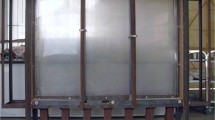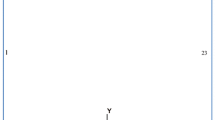Abstract
Additional stresses caused by a flexible barrier, drawpoints and the self-weight of ore particles were investigated based on a physical experiment of the shrinkage stoping method of synchronous filling, and the flow behaviour of ore particles is described by the component forces. This study shows that when ore particles are drawn from multiple drawpoints under the influence of a flexible barrier, the stress distribution of the ore particles is sinusoidal, with an amplitude that gradually decreases with increasing height. The values of σx and σy gradually decrease with increasing height; the maximum σy values occur at x = 0, the maximum σx values occur at x = ± 10 and the maximum shear stresses occur near the lateral walls. The shape of the draw column is determined by the additional vertical stress, and its contour determines the essential morphology of the drawbody. The surface of the ore particles is smoothed by the additional stress caused by the barrier, and the self-weight of the ore particles is the inherent cause of the additional stress.














Similar content being viewed by others
References
Bian ZF, Yang HI, Daniels JL, Frank O, Sue S (2010) Environmental issues from coal mining and their solutions. Int J Min Sci Technol 20:215–223
Bloom JA, Gallant L (1994) Modelling dispatch constraints in production cost simulations based on the equivalent load method. IEEE Trans Power Syst 9:598–611
Chen QF, Chen QL (2015) Synchronous filling mining technology idea and a kind of representative mining method. China Min Mag 24:86–88
Chen QF, Wu ZX (2010) A large number of ore drawing synchronous filling no-top-pillar shrinkage stopping method. CN
Chen QF, Chen QL, Zhong JY (2016) Flow pattern of granular ore rock in a single funnel under a flexible barrier. Chin J Eng 38:893–898
Chen QF, Zhao FY, Chen QL, Wang YD, Zhong Y, Niu WJ (2017) Orthogonal simulation experiment for flow characteristics of ore in ore drawing and influencing factors in a single funnel under a flexible isolation layer. JOM 69:2485–2491
Chen QF, Qin SK, Chen QL (2019) Numerical simulation of ore particle flow behaviour through a single drawpoint under the influence of a flexible barrier. Geofluids 2019:1–11
Doronzo DM (2013) Aeromechanic analysis of pyroclastic density currents past a building. Bull Volcanol 75:684
Itasca CG (2008) PFC3D (particle flow code in 3dimensions) FISH in PFC3D. Itasca Consulting Group Inc, Minnesota
Jiang HY, Lu JB, Hui FC (2004) Stress distribution in disperse grain pack. J Lanzhou Univ Technol 30:106–109
Kieffer SW (2017) Researching the Earth - and a few of its neighbors. Annu Rev Earth Planet Sci 45:1–29
Liu YS, Guo LY, Ren ZY (2006) The causes of land landscape changes in semi-arid area of Northwest China: a case study of Yulin city. J Geogr Sci 16:192–198
Liu Z, Zhou N, Zhang JX (2013) Random gravel model and particle flow based numerical biaxial test of solid backfill materials. Int J Min Sci Technol 23:463–467
Long RY, Zhang XT (2009) Negative entropy mechanism of the circular economy development countermeasures in mining area. Procedia Earth Planet Sci 22:1678–1685
Milanez B, Oliveira J (2013) Innovation for sustainable development in artisanal mining: Advances in a cluster of opal mining in Brazil. Res Policy 38:427–434
Rajchenbach J (2001) Stress transmission through textured granular packing. Phys Rev E 63:041301
Tao GQ, Yang SJ, Ren FY (2009) Experimental study on flow parameters of random medium droplet. Chin J Rock Mech Eng 28:3464–3470
Xu ZL (1982) Elastic mechanics. People’s Publishing House, Beijing
Zeng YL (1988) Displacement solution of plane problem of elasticity. Chin J Theor Appl Mech 20:93–98
Zhang SH, Li RF, Liu YX (2006) Study on stress field of caving rock movement. Nonferrous Metal 58:25–27
Zhu ZH, Wang LG, Tu XT (2016) Flow characteristics of discrete ore rock of block caving based on stochastic medium theory. J Northeastern Univ 37:869–874
Funding
This work was financially supported by the National Natural Science Foundation of China (grant no. 51464005).
Author information
Authors and Affiliations
Corresponding author
Additional information
Editorial handling: Domenico M. Doronzo
Appendices
Appendix 1. General solution to the stress of a semi-planar body subjected to a concentrated force at the boundary
The problems described by Eqs. (3), (5) and (8) belong to the problem of a semi-planar body subjected to a concentrated force at the boundary. Therefore, we first introduce the general solution of the stress to the problem of a semi-planar body subjected to a concentrated force at the boundary.
Suppose a semi-planar body is subjected to a concentrated force F (dimension MT−2) on its straight boundary, and the coordinates of any point P in the plane are (ρ, φ), as shown in Fig. 15.
The semi-inverse method is used to solve the problem, and the stress function of the model is assumed to be ϕ. From dimensional analysis (Xu 1982), we know that ϕ is a function of φ times ρ, namely:
Substituting Eq. (13) into the compatibility equation of the stress function in polar coordinates provides:
Normalising by the factor \( \frac{1}{\rho^3} \) and solving this ordinary differential equation provides:
The stress is the second partial derivative of the stress function ϕ, while the first two terms Aρ cos φ + Bρ sin φ = Ax + By in Eq. (15) are the first terms of x and y, so these two terms do not affect the stress. Therefore, we need to consider only the following:
According to the calculation formula of the stress component (Xu 1982), the following can be obtained:
Next, the stress boundary conditions are investigated, and the unknown coefficients in Eq. (17) are determined. There are no normal or tangential surface forces along φ = 0and φ = π; thus, the stress components σφ and τρφ need to satisfy (σφ)φ = 0, π, ρ ≠ 0 = 0, (σφ)φ = 0, π, ρ ≠ 0 = 0. According to Eq. (17), stress components σφ and τρφ satisfy these two boundary conditions.
In addition, point O should be considered subject to the concentrated force F. According to Saint-Venant’s principle, a small detached body Oabc is cut out near point O (Fig. 15). Then, considering the equilibrium condition of the detached body, three equilibrium equations are listed:
Substituting the stress component in Eq. (17) into Eq. (18), it can be obtained that:
Substituting Eq. (19) into Eq. (17) to obtain the final solution of the stress component (i.e. the Flamant solution) provides:
Using the coordinate transformation formula, the stress component in rectangular coordinates can be obtained from the above formula:
This is the stress component in rectangular coordinates expressed in polar coordinates. The polar coordinates in Eq. (21) can also be transformed into rectangular coordinates to obtain:
Appendix 2. Eq. (3)
In Fig. 7, the projected component in the vertical direction at point N is Q(ξ), and the concentrated force acting on the hypotenuse of the differential element is \( d{F}_1=\sqrt{1+{\left(D\hbox{'}\right)}^2}Q\left(\xi \right) d\xi \). Its stress on any point M of the ore particles belongs to the problem of the semi-planar body subjected to a concentrated force at the boundary, which can be solved by Eq. (22). Equation (3) can be obtained by substituting the relevant parameters of the model into Eq. (22):
Appendix 3. Eq. (5)
In Fig. 7, the projected component in the horizontal direction at point N is S(ξ), and the concentrated force acting on the hypotenuse of the differential element is \( d{F}_2=\sqrt{1+{\left(D\hbox{'}\right)}^2}S\left(\xi \right) d\xi \). Its stress on any point M of the ore particles belongs to the problem of the semi-planar body subjected to a concentrated force at the boundary, which can be solved by Eq. (22). Equation (5) can be obtained by substituting the relevant parameters of the model into Eq. (22):
Appendix 4. Eq. (8)
In Fig. 8, there is an equivalent load F3 at each drawpoint. The effect of any equivalent load F3 on a point in the model can be regarded in terms of the problem of a semi-planar body subjected to a concentrated force at the boundary. Substituting the relevant parameters of the model into Eq. (22), the stress at a point of the model under any equivalent load F3 can be obtained:
By superimposing the stress caused by seven equivalent loads at the same point in the model, Eq. (8) can be obtained:
Rights and permissions
About this article
Cite this article
Chen, Q., Qin, S. & Chen, Q. Stress analysis of ore particle flow behaviour under the influence of a flexible barrier. Arab J Geosci 12, 472 (2019). https://doi.org/10.1007/s12517-019-4658-8
Received:
Accepted:
Published:
DOI: https://doi.org/10.1007/s12517-019-4658-8





